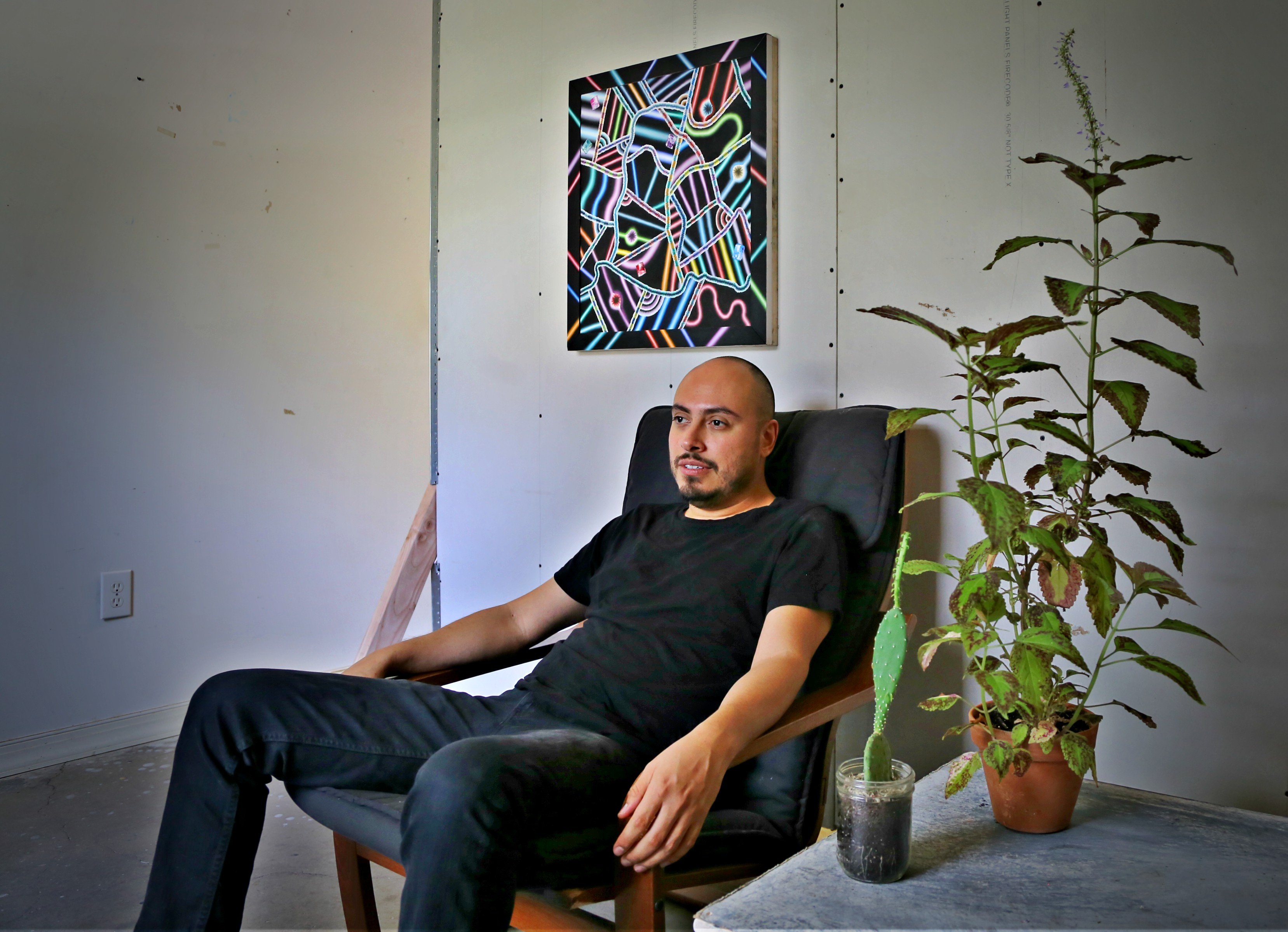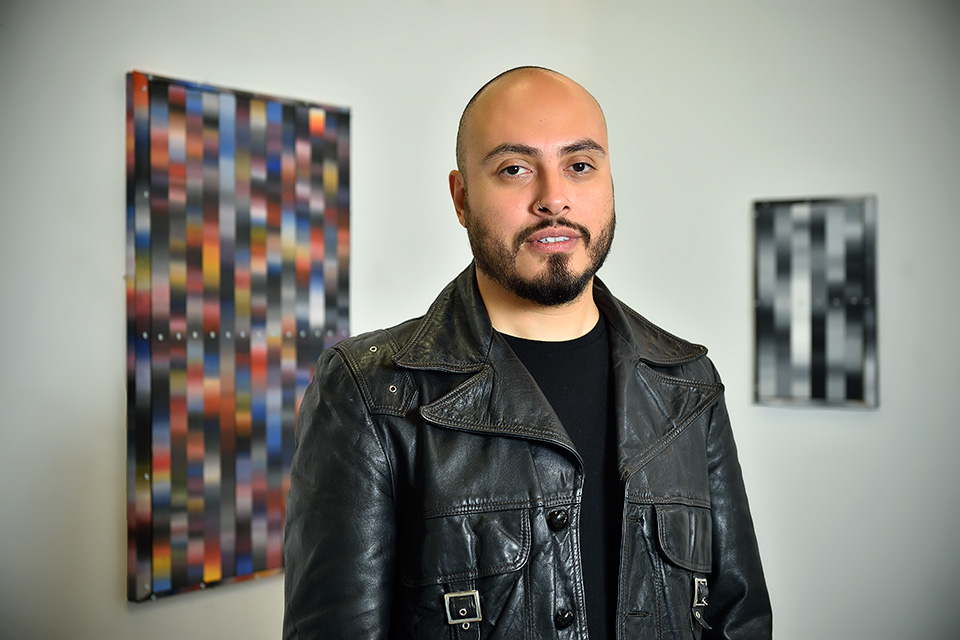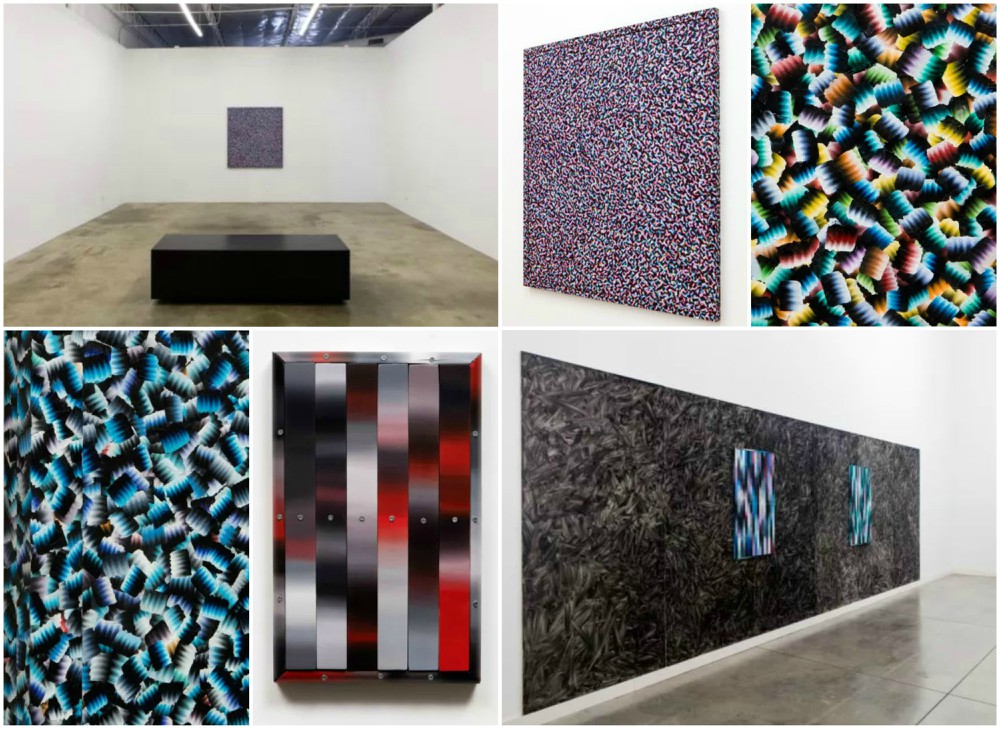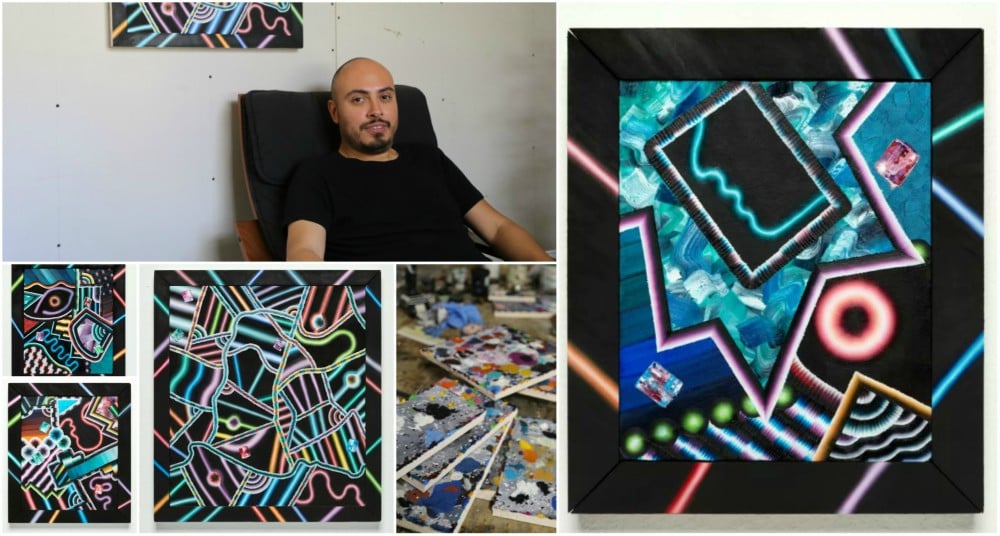An Attempt At Capturing Perfection
ArtandSeek.net October 5, 2017 40Welcome to the Art&Seek Artist Spotlight. Every Thursday, here and on KERA FM, we’ll explore the personal journey of a different North Texas creative. As it grows, this site, artandseek.org/spotlight, will eventually paint a collective portrait of our artistic community. Check out all the artists we’ve profiled.

Arthur Peña sits in his studio. He says having plants in the room give him light and life.
Photo: Hady Mawajdeh
For artist Arthur Peña, painting is more than a craft – it’s a relationship. The affair began as a kid growing up in South Dallas.
“I grew up in Oak Cliff in a two-and-a-half bedroom house,” Peña explains. “It was just your average working-class family house. Except that it was full of lots of arts supplies for my mother. She’s a painter.”
The Dallas native says his parents kept him pretty busy. His father played sports with him and his mother encouraged his interest in arts and crafts. But he never really left his neighborhood.
“I really didn’t know anything beyond Oak Cliff, the block I grew up on and the schools I was going to,” Peña says. “I really didn’t know anything beyond that. Definitely didn’t know what Dallas was, except that it was a place that could harbor lots of violence.”
Peña says his block saw lots of gang activity. His high school was fragmented. Kids from different barely spoke. And he was shy and sensitive, he needed a way to vent.
“I knew I had to find a way to express myself that was not partying all the time or joy riding or something, because those things were definitely happening. And I just sort of became this kid who locked himself in his room and started painting stuff,” says Peña.

Peña says his artwork began with comic book characters. He still keeps toys like this in his studio.
Photo: Hady Mawajdeh
It was around that time that Peña began to think of art as a friend. Painting helped through college at UNT. It took him to Chicago to attend the School of the Art Institute of Chicago. And eventually he earned an MFA from the Rhode Island School of Design. He moved back to Dallas, started an arts collective and an underground music label called Vice Palace. He got noticed. And it seemed that painting would always be there for him.
But at the start of 2016, Peña and painting were on the skids.
“I sort of lost a lot of things that I felt defined me, you know jobs, people, situations and sort of out of nowhere. And I found myself honestly just like a broken person,” Peña says.
Peña’s work is labor intensive. Each painting features thousands of one-inch geometric figures. And some pieces took months to finish.
“The work up until that point was very symmetrical,” Peña says. “It had a very all over [the place] composition and that kind of work is really about making and doing and trusting in the process.”
But Peña says he didn’t have the energy or spirit to keep going. So he decided stop working.
“During that time you feel guilty because you’re not making and you want to, but you can’t. And then it gets wrapped up in this whole other thing and it just snowballs into this mass of depression and anxiety and guilt,” says Peña .
Then, last fall, Peña began teaching at SMU. He says that was therapeutic – it allowed him more time in the studio. Plus, he was able to have intellectual conversations about art with his students, which helped snap him out of his depression.
“It was like revisiting an old friend, an old lover or a distant family member who you haven’t talked to in a long time or something. Somebody you share a lot of memories with,” says Peña.
When he returned to the canvas, Peña felt different about painting and it showed.
“With this new work it was very much about composing, doing this dance with the paintings, doing something, stepping back, listening, looking, responding – so the whole way of making the painting started to change, because frankly I was a different person,” he says.
Peña’s newer works featured black canvases, painted over with brightly colored shapes. And the human figure began to make appearances.
“There’s something really wonderful about Arthur,” says Justine Ludwig. Ludwig’s the Director of Exhibitions and the Senior Curator at the Dallas Contemporary. “He does everything with the utmost sincerity.”
She describes Peña’s work as exciting and inspirational.
“When you see his work, each piece is unbelievably intimate. And you get to sort of see what you see,” she says. “You can investigate aspects of your own life within his practice.”
One of the facets that excites Ludwig most about Peña’s work are the titles. He calls his paintings “attempts.” And that’s because they are sequential. No work is ever truly complete. Instead he’s continuously trying to complete the perfect work.
“I always talk about my paintings and my work and the attempt as this way to sort of keep up with the day,” Peña says. “Every day’s going to be different. You have no idea what’s going to happen. And that’s just how I think about painting.”
Peña’s one of the region’s most productive creators. He’s painted hundreds of pieces. He runs a music label. He’s dabbled in experimental theater. Each project is an attempt at creating something worthwhile. And each attempt strengthens his relationship to art.
Are you creatively satisfied?
No. I always feel like I can do more work and do more things. Coming back to Dallas in 2012, that’s really when I felt like Dallas was my city. I understood it in this other way. I saw where I fit in in this place. It wasn’t just the city I grew up in. It was this city that I could contribute to and build up. So, in that way, there’s always work to do. I’m always going to believe that high tide raises all ships. I’m always going to want to put my friends on blast and put talent out there when I can.
So, the studio is always a place of doubt and anxiety and small accomplishments, but there’s never really any satisfaction because that’s just not what this job is. To me at least, it’s not about satisfaction because the moment a show is mounted or an album comes out or a book is published — and any artist will tell you this — that person is immediately thinking, what’s next?
How do find and maintain balance?
At this moment in my life, I think balance is a myth. There’s no way. There’s no way. Something or somebody is always going to get the short end of the stick.
You have to spend the time in the studio, so maybe you don’t grade these papers as fast. Maybe you don’t follow up on that dinner you’re supposed to have. Or you’re working hard in your job and that’s taking your time and you don’t have the energy for these other things.
I don’t really think there is a balance. I think it’s a nice thing to believe in. I think it’s a nice thing to strive for, obviously. I’m not saying I don’t try, but this isn’t really the kind of lifestyle that offers balance. An attempt, by definition, is a concerted effort. That’s what all of this is. All I can do is try.
How does North Texas influence your art?
North Texas? I don’t think about it. I think about Dallas … Dallas has given me everything. It has many layers, and it’s complicated in its many forms. It has allowed me to be here talking to you about things I’ve done in this city … Dallas has provided that for me. I’m from here, so I do it here. That’s what matters to me. That I try and champion this city and its creatives the way people have done for me. This is why I believe in teaching. I believe education is completely important. Academia saved my life. It gave me the time I didn’t know I needed. That’s a privilege, and I see that.
What this city values more than anything is an entrepreneurial spirit. A “pull yourself up by the bootstraps” mentality, which is not necessarily where I come from but it recognizes that for better or for worse. That’s what makes this town move and function. That sense of itself.
That identity of Dallas is also its biggest enemy in that it always seemingly wants to be something when it already is something else. Do I wish more artists were here? Yes. Do I wish that we could have ultimate creative freedom in this city? Absolutely. Do I want Dallas to be a place that people are attracted to because of its cultural capital? Sure. Above all, I just want Dallas to be a place that allows for free thought and expression. If I can facilitate that in any way, then in that way I’ll make Dallas mine.

Artist Arthur Pena photographed in his west Dallas studio for North Texan in Dallas, Texas on May 14, 2015. Photos: Michael Clements.
What makes your work special?
I think everybody brings their own specific experience to their field. Their passion. Their life.
The story that sums it up is going to the campus at SMU as a teenager in high school with a friend to go pick up something from his father, who was a janitor there. When I saw that campus — it was the first college campus I had seen in my life except for on TV — I thought, My God, this is so beautiful … I had no idea a place like that existed in real life. I ended up borrowing my parent’s car a couple of weeks later and taking a backpack full of comic books to SMU, parked on a side street, and walked onto that campus and pretended like I went there. I had no idea what SMU was. I just knew this was a quiet place and it was beautiful. I thought to myself, maybe one day I can be in a place like this.
I didn’t go back to that campus again until I came back as the full-time visiting lecturer in painting at Meadows School of Art. The experiences that I’ve had as that 17-year-old who felt like they didn’t belong on that campus and as a professor coming into that campus to teach students — that chasm has given me every gear that I have because in between that time, so many things have happened.
I’ve lived a life of a blue-collar Hispanic male (whatever that means), and I’ve found myself attending elite institutions talking to people that go to Harvard. Those disparate experiences really showed me that there’s no difference between people. If anything, what makes my voice powerful is that I’ve been forced to and have had the opportunity to know what it’s like in all ranges of class and culture and it’s only made me more grateful for my time and has really made me grateful for the people I’ve met.
What did you think about the opportunity to show in a space like EXPO CHICAGO?
Whoever sees the paintings, I’m always aware of the fact that they bring their own stories to it and their own lives to it. There are variations in terms of demographics and the backgrounds that people may have in these different spaces, but my job is to make the paintings. Not my job, my truth. When I’m doing that, I win. Every day that I get to wake up and make a painting, think about paintings, talk about painting, I win.
I’m excited about Chicago because I’m going to share it with one of my best friends Kevin Jacobs, who has been an integral part of my life in this city and who I love very much. For me, that’s what this is about.
I go back to one of my favorite painters who I had the chance to talk to recently. That’s Stanley Whitney, who had a show at the Fort Worth Modern. I had talked to him when I was at RISD. He did a graduate studio visit with me. When we talked this time, he remembered me and we talked about his work and he asked me what I was up to. I sort of asked him the same question you asked me. I said, Stanley, you grew up poor. You talk about it. How did that affect your vision for your life and your path to becoming a painter? He responded in this beautiful, honest way. He talked about growing up in the South and having police come over as a child in the 1950s and living with his brothers and sisters in this small apartment while his dad sold insurance. He also talked about what it was like making work in the ’60s. He said, you know, the Black Panthers knocked on my door. I told my mom to tell them I wasn’t home because I had to paint. That was my role.
I think about that during this time of political upheaval. I think about my role and responsibility in making things. What should they be about? Should they be about this stuff? Should they address certain issues? Is that my role as someone who has a voice to bring? A voice for the voiceless? Yes, absolutely. But, I do that in different ways. What these paintings are about for me is living my truth and paying attention to this life that I’m in. What Stanley said in response to my question to him was that you have to be the artist that you are. You can’t fight it. Whatever artist is in that studio at that time, that’s what’s going down. For me, sharing the work, sharing this sincere experience that happens to be in the output of paintings, that’s all I care about.
Interview questions and answers have been edited for brevity and clarity.












